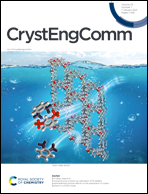Synthesis, structure, and heterogeneous Fenton reaction of new Cu(ii)-based discrete Cu2Lx coordination complexes†
Abstract
Discrete and polymeric coordination complexes, namely [Cu2L4(ClO4)4]·2CH2Cl2·CH3OH (1), [Cu2L2(NO3)4(CH3OH)2] (2) and {[Cu2L4(NO3)4]}n (3), were obtained using bridged pyridine ligand 4-methyl-2,6-bis(pyridinyl-3-ethynyl)aniline (L) and Cu(II) salts in CH2Cl2/MeOH. The structure of the Cu2L4 cage or Cu2L2 macrocycle was generated depending on the selection of the anion (ClO4−/NO3−). The heterogeneous Fenton reaction experiments using H2O2 showed that discrete coordination complexes are good photocatalysts in which the Cu–N bond plays a major role in the photocatalytic degradation. The degradation mechanism could be described as a synergistic process of the Fenton reaction and high-valence copper ions using t-butanol as the hydroxyl radical scavenger. The photocatalytic degradation of methylene blue (MB) experiments showed that the photodegradation efficiency of the coordination complexes is higher than that of the polymeric Cu-MOFs.

- This article is part of the themed collection: Coordination Networks


 Please wait while we load your content...
Please wait while we load your content...